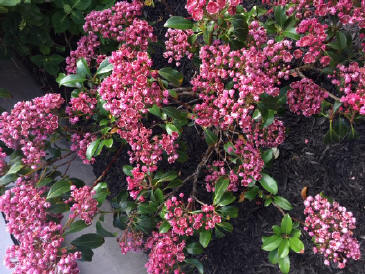 (4/15) Trees and shrubs play an essential role in our landscape. They provide a long-term benefit to the gardener as they produce oxygen and absorb harmful carbon from the atmosphere. Trees and shrubs stabilize the soil from erosion as they assist with filling the soil with nutrients, and provide food and habitat for wildlife. As the winter months wane and hints of spring are present, it is exciting to see trees and shrubs swell with the promise of blooms to soon make their stunning appearance.
(4/15) Trees and shrubs play an essential role in our landscape. They provide a long-term benefit to the gardener as they produce oxygen and absorb harmful carbon from the atmosphere. Trees and shrubs stabilize the soil from erosion as they assist with filling the soil with nutrients, and provide food and habitat for wildlife. As the winter months wane and hints of spring are present, it is exciting to see trees and shrubs swell with the promise of blooms to soon make their stunning appearance.
As you prepare for springtime additions to your landscape, choose a reputable garden center with knowledgeable employees who will assist you with any questions. Always read the tags because they contain valuable information concerning your purchase choices.
Spicebush (Lindera benzoin) is a shrub for consideration. It is an eye-catching native shrub that has spicy-scented pale-yellow flowers that bloom in the spring. The leaves and stems are also aromatic with a spicy, citrusy smell. In autumn the leaves are a vibrant yellow color. It is deciduous (loses its leaves in the fall). It prefers full to partial sun and moist, well-drained soil. Spicebush is a host plant for swallowtail butterflies, whose larvae feed on it. This shrub may be pruned for aesthetic reasons after it has finished blooming in the spring.
Mountain Laurel (Kalmia latifolia) is a showy shrub that is native to eastern North America. This shrub is naturally found on rocky slopes and mountainous forest areas. Governor Gifford Pinchot designated Mountain Laurel as Pennsylvania’s official state flower in 1933. Many different cultivars of Mountain Laurel are available that offer a variety of bloom hues. Most are 4-6 feet tall, but there are also several dwarf varieties that will reach just 3 feet in height. This shade-loving shrub produces clusters of small flowers in late May to early June. The clusters range from white to pink to deep rose. When the buds burst open in the spring, the branches are virtually obscured by the blooms. An added bonus of growing Mountain Laurel is that bees, butterflies, and hummingbirds are attracted to its flower clusters.
Oakleaf Hydrangea (Hydrangea quercifolia) is one our most beautiful native woody perennial species in the United States. Large clusters of white flowers bloom in late spring. The blooms are covered by sepals and strong, sturdy stems. Their vivid flower color makes this a delightful selection for your garden landscape. As the blooms progress into summer, they turn to pink and reddish pink hues in the fall. The broad, dark green leaves are oak-shaped, giving the plant its name. This bush typically grows 4 to 8 feet high and wide. It can be pruned considerably in the fall to control its size. An Oakleaf Hydrangea is a very adaptable shrub because it can take partial sun or shade. It requires moderate water when recently planted, but after it has been established it can tolerate drought.
Witch hazel (Hamamelis) is a genus of deciduous slow-growing small trees and shrubs. There are many cultivars that bloom from January to March. Each bloom has four wispy petals radiating outward. Depending on the cultivar, the flowers are bright yellow, apricot, orange or red. They prefer partial shade but can survive in full sun if watered. The native witch hazel (Hamamelis virginiana) has a spice-scented flower that blooms in October and November.
Rhododendrons and Azaleas offer a wide variety of flower colors that bloom in the spring. These are some of the most popular landscape plants in Pennsylvania. They are members of the Ericaceae family and the genus Rhododendron. They have a wide range of heights and widths for selection. They prefer cool, moist, and well-drained acidic soil (pH 4.5-5.5) and partial sunlight. Pinxter flower (Rhododendron periclymenoides) is native to the Mid-Atlantic region.
Eastern Redbud (Cercis canadenis) is a an attractive, small, native tree with pinkish-purple flowers that cover the branches before the leaves emerge in the spring. The blossoms provide an early spring source of pollen and nectar for bees. A charming characteristic of the Eastern Redbud is its heart-shaped green leaves. This is a deciduous tree that benefits from well-drained soil and prefers to be planted in a location that provides full sun to part shade. In the landscape, Eastern Redbuds are beautifully accented with daffodils, tulips, hyacinths, and other spring flower bulbs at its base. The Gettysburg National Military Park is a showcase for Eastern Redbuds.
A Crabapple tree (Malus) is an excellent choice for the home landscape because of its adaptability and diversity. A wide range of cultivars exist in different sizes and shapes with flowers in white, pink, red, and pinkish-purple. Some of the newer cultivars produce very small red crabapples for the birds to enjoy in the winter. Crabapples like well-drained soil and a partial or full sun location. It is important to select a cultivar resistant to apple scab.
Pagoda dogwood (Cornus alternifolia) is an outstanding native plant that displays clusters of white flowers in the spring. The blooms are exhibited against dark green foliage. Pagoda dogwood prefers to reside in a shade garden.
Gardeners with small spaces can contribute to the benefits of trees and shrubs to our environment as they create beauty in the spring. With selective planning, the environment will be enriched, wildlife will benefit from the plantings, and there will be a continual masterpiece of beauty to enjoy for many years.